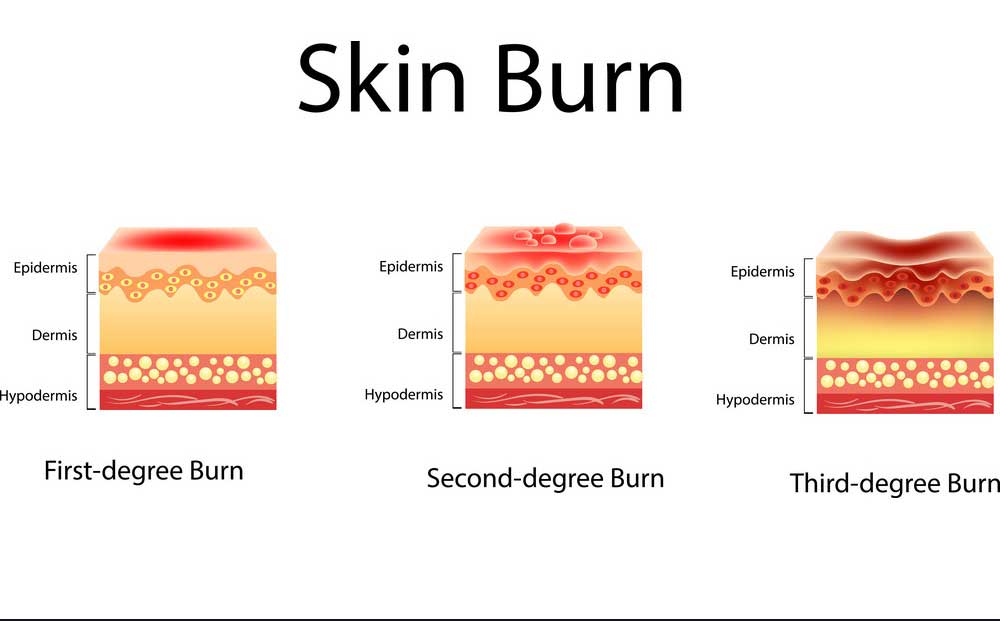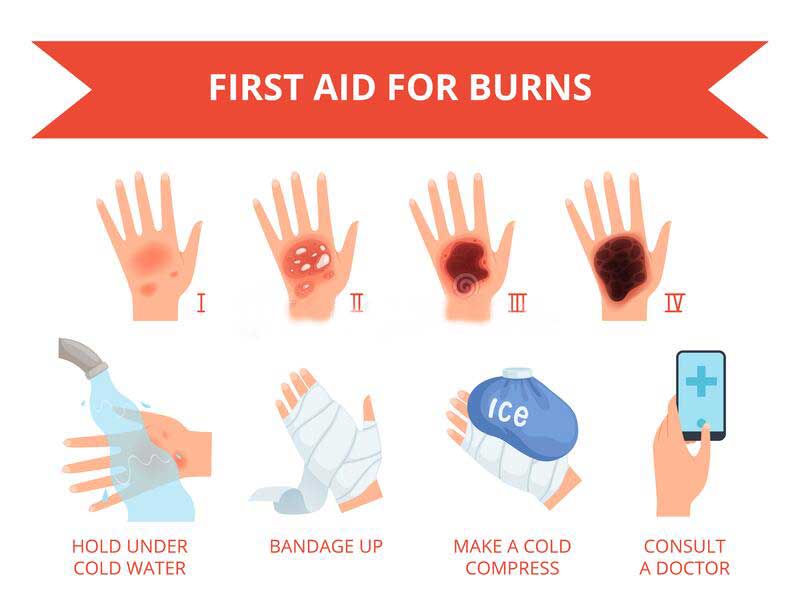Burns are tissue damage that is caused by heat, chemicals, electricity, radiation, or the sun. It can be either minor medical problems or life-threatening emergencies.
The treatment depends on the degree of burns and the location of the injury. First-degree burns and second-degree burns can be healed or treated at home. Third-degree burns are dangerous, it requires particular medical care and treatment.
Accidental burns can happen to children, teenagers, and older people. But older people are at high risk. Burns can be painful. If it is left untreated, the infection may take place. Almost half a million Americans seek medical care for accidental burns.
TYPES OF BURNS
The burns degrees are dependent upon the intensity of burns. Burn degrees include:
- First-degree burns are mild. In this type, the top layer of skin (epidermis) turns red. It may cause pain.
- Second-degree burns affect the skin’s top and lower layers (dermis). In this type of burns, you may experience pain, redness, swelling, and blistering.
- Third-degree burns affect all three layers of skin that are epidermis, dermis, and fat. It destroys hair follicles, sweat glands, and damages nerve endings.
If you or someone has met any of the following conditions, call 911 for an emergency.
The burn sticks all layers of the skin. The skin is charred-looking, with white, brown, or black patches. If anyone is an infant or a senior.

CAUSES
There are many things that can cause a burn. The most common thermal sources can cause burns such as fire, hot liquids, and steam.
Other causes include:
- Chemicals, such as cement, strong acids, lye, paint thinner, or gasoline.
- Radiation, such as X-rays.
- Electricity.
- Sun (ultraviolet or UV light).
- Abuse.
- Contact with hot metal, glass, or other objects.
- First Aid For Burns
COMPLICATIONS
The first- and second-degree burns can cause discoloration and scarring. Third-degree burns are very serious that affect a large portion of the skin.
Complications of third-degree burns include:
- Arrhythmia
- Dehydration.
- Disfiguring scars and contractures.
- Bone and joint problems
- Edema (excess fluid and swelling in tissues).
- Organ failure.
- Pneumonia
- Low blood pressure (hypotension).
- A bacterial infection that may lead to bloodstream infection (sepsis)
- Low body temperature (hypothermia)
- Breathing problems
- Scars
WHAT ARE THE SIGNS OF BURNS?
Burn symptoms depend on the intensity of the burn. In the first few hours or days after the burn, you may experience blisters, pain, swelling, white or charred (black) skin, and peeling skin.
DIAGNOSIS
Your doctor will check your injury and estimate the percentage of the burn and its depth on the body. They will examine your affected part of the skin before recommending any treatment.
If your burn covers more than 10 percent of your total body surface area or you meet other criteria established by the American Burn Association, the doctor will transfer you to a burn center.

TREATMENT
You need to keep all your burns clean. The bandages or dressing of the wounds rely on the severity of the injury. Some people need treatment at particular burn centers and months-long follow-up care.
Until emergency help arrives follow below treatment options:
Treating minor burns:
- Keep the burned area under cool running water. Don’t apply ice. You can apply aloe vera gel to ease the pain.
- Quickly and gently remove your ornaments from the affected area.
- Fluid-filled blisters protect against infection so, don’t break blisters. If a blister breaks, clean the area.
- Apply an antibiotic ointment.
- Once a burn is completely cooled, apply a lotion on it that helps prevent drying and you will get relief from pain.
- Cover the burn with a sterile gauze bandage (not fluffy cotton).
- Wrap it loosely to reduce pain and protect blistered skin.
- If needed, take an over-the-counter pain reliever, such as ibuprofen (Advil, Motrin IB, others), naproxen sodium (Aleve), or acetaminophen (Tylenol, others).
Treating major burns:
- Stop Burning Immediately. Save the burned person.
- If the person is in contact with a burn, make sure to use a fire extensor or use water. Don’t soak large severe burns in water.
- Remove hot or burned clothes.
- For electrical burns, make sure the power source is off before.
- Burned areas swell rapidly, so remove jewelry, belts, and other items.
- Cover the area of the burn.
- Use a cool or clean cloth.
SURGICAL PROCEDURES
You may need any of the following procedures:
- Breathing assistance – If your throat has been swelling shut, you need breathing assistance. Doctors may insert a tube down your windpipe and supply oxygen to your lungs. This is applicable to those who have been burned on the face or neck.
- Feeding tube – The feeding tube is inserted through your nose to your stomach.
- Blood flow Relieve- When a burn scab goes around a limb, it results in poor blood circulation and makes it difficult to breathe. Your doctor may cut the eschar to ease the blood flow.
- Skin grafts – A skin graft is a surgical procedure in which your own skin is used to replace the scar tissue caused by deep burns.
- Plastic surgery – Plastic surgery reconstructs the appearance of burn scars and increases the flexibility of joints affected by scarring.
HOME REMEDIES FOR BURNS
Mild burns typically take a week or a month to totally heal. The main target of burn treatment is to relieve pain, head off infections, and heal the skin faster.
- Cool water – When you get a minor burn, hold it under running cool water for about 20 minutes. Then wash the burned area with mild soap.
- Cool compresses – A cool compress or clean wet cloth put down over the burn area. You can apply the compress again in 5- to 15-minute intervals. It helps relieve pain and swelling.
- Antibiotic ointments – Apply an antibacterial ointment like Bacitracin or Neosporin to your burn skin. Antibiotic ointments and creams help prevent infections.
- Aloe vera – Aloe vera is very effective in healing first- to second-degree burns. Apply a layer of pure aloe vera gel directly to the affected area. Avoid using products that have additives, especially coloring and perfumes.
- Honey – Honey is anti-inflammatory and naturally antibacterial and antifungal. You can apply it to the burnt area, it helps heal a minor burn.
- Reducing sun exposure – The Sun Is Hot, Don’t Let It Burn You. The burned skin is very sensitive. Avoid exposing the burn to direct sunlight, keep it covered with clothing.
- Don’t pop your blisters – Leave your blisters alone. Bursting a blister can lead to infection.
- Take an OTC pain reliever – Take an over-the-counter (OTC) pain reliever such as ibuprofen (Motrin, Advil) or naproxen (Aleve).
Look around for emergency medical care for deep burns that involve your hands, feet, face, groin, buttocks, a major joint, or a large area of the body.
Your emergency physician may recommend you to a skin specialist (dermatologist), burn specialist, surgeon, or another specialist.
If you or anyone you know accidentally met a burn, our expert providers at Specialty Care Clinics will take care of your health and help you recover. You may need an appointment with our expert doctor.
Call us on 469-545-9983 to book an appointment with Dr. Rao Kamran Ali.
